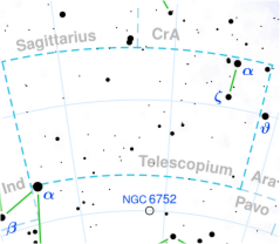Astronomy:HD 174387
| Observation data Epoch J2000.0 Equinox (celestial coordinates) | |
|---|---|
| Constellation | Telescopium |
| Right ascension | 18h 52m 27.2298s[1] |
| Declination | −46° 35′ 42.4326″[1] |
| Apparent magnitude (V) | 5.49±0.01[2] |
| Characteristics | |
| Spectral type | M0 III[3] |
| B−V color index | +1.63[4] |
| Variable type | suspected[5] |
| Astrometry | |
| Radial velocity (Rv) | −28.1±0.9[6] km/s |
| Proper motion (μ) | RA: +28.229[1] mas/yr Dec.: −0.941[1] mas/yr |
| Parallax (π) | 4.0175 ± 0.1091[1] mas |
| Distance | 810 ± 20 ly (249 ± 7 pc) |
| Absolute magnitude (MV) | −1.97[7] |
| Details | |
| Mass | 1.14[8] M☉ |
| Radius | 82.63[9] R☉ |
| Luminosity | 902[10] L☉ |
| Surface gravity (log g) | 0.79[8] cgs |
| Temperature | 3929±122[11] K |
| Metallicity [Fe/H] | −0.04[8] dex |
| Other designations | |
| Database references | |
| SIMBAD | data |
HD 174387 (HR 7092) is a solitary[14] star in the southern constellation Telescopium. With an apparent magnitude of 5.49,[2] it is faintly visible to the naked eye if viewed under dark skies. Parallax measurements put the object at a distance of 810 light years[1] and it is currently approaching the Solar System with a heliocentric radial velocity of −28.1 km/s.[6]
HD 174387 has a stellar classification of M0 III,[3] indicating that it is an ageing red giant. Due to its evolved state, the star has expanded to a diameter of 82.63 R☉.[9] At present it has 114% the mass of the Sun[8] and shines 902 times the luminosity of the Sun[10] from its enlarged photosphere at an effective temperature of 3,929 K,[11] giving a red hue when viewed. HD 174387's metallicity is estimated to be 91% that of the Sun.[8] The star is suspected to be variable, ranging from magnitudes 5.59 to 5.63 in the Hipparcos passband.[5]
References
- ↑ 1.0 1.1 1.2 1.3 1.4 Brown, A. G. A. (2021). "Gaia Early Data Release 3: Summary of the contents and survey properties". Astronomy & Astrophysics 649: A1. doi:10.1051/0004-6361/202039657. Bibcode: 2021A&A...649A...1G. Gaia EDR3 record for this source at VizieR.
- ↑ 2.0 2.1 Høg, E.; Fabricius, C.; Makarov, V. V.; Urban, S.; Corbin, T.; Wycoff, G.; Bastian, U.; Schwekendiek, P. et al. (March 2000). "The Tycho-2 catalogue of the 2.5 million brightest stars". Astronomy and Astrophysics 355: L27–L30. ISSN 0004-6361. Bibcode: 2000A&A...355L..27H.
- ↑ 3.0 3.1 Houk, Nancy (1978). "Michigan catalogue of two-dimensional spectral types for the HD stars". Ann Arbor: Dept. Of Astronomy. Bibcode: 1978mcts.book.....H.
- ↑ Corben, P. M. (April 1971). "Photoelectric Magnitudes and Colours for Bright Southern Stars". Monthly Notes of the Astronomical Society of South Africa 30 (4): 37. ISSN 0024-8266. Bibcode: 1971MNSSA..30...37C.
- ↑ 5.0 5.1 Samus’, N. N.; Kazarovets, E. V.; Durlevich, O. V.; Kireeva, N. N.; Pastukhova, E. N. (January 2017). "General catalogue of variable stars: Version GCVS 5.1". Astronomy Reports 61 (1): 80–88. doi:10.1134/S1063772917010085. ISSN 1063-7729. Bibcode: 2017ARep...61...80S.
- ↑ 6.0 6.1 Wilson, Ralph Elmer (1953). "General catalogue of stellar radial velocities.". Carnegie Institute Washington D.C. Publication: 0. Bibcode: 1953GCRV..C......0W.
- ↑ Anderson, E.; Francis, Ch. (May 2012). "XHIP: An extended hipparcos compilation" (in en). Astronomy Letters 38 (5): 331–346. doi:10.1134/S1063773712050015. ISSN 1063-7737. Bibcode: 2012AstL...38..331A.
- ↑ 8.0 8.1 8.2 8.3 8.4 Anders, F. et al. (August 2019). "Photo-astrometric distances, extinctions, and astrophysical parameters for Gaia DR2 stars brighter than G = 18". Astronomy & Astrophysics 628: A94. doi:10.1051/0004-6361/201935765. ISSN 0004-6361. Bibcode: 2019A&A...628A..94A.
- ↑ 9.0 9.1 Kervella, Pierre; Arenou, Frédéric; Thévenin, Frédéric (2022). "Stellar and substellar companions from Gaia EDR3". Astronomy & Astrophysics 657: A7. doi:10.1051/0004-6361/202142146. ISSN 0004-6361. Bibcode: 2022A&A...657A...7K.
- ↑ 10.0 10.1 Brown, A. G. A. (August 2018). "Gaia Data Release 2: Summary of the contents and survey properties". Astronomy & Astrophysics 616: A1. doi:10.1051/0004-6361/201833051. Bibcode: 2018A&A...616A...1G. Gaia DR2 record for this source at VizieR.
- ↑ 11.0 11.1 Stassun, Keivan G. et al. (9 September 2019). "The Revised TESS Input Catalog and Candidate Target List". The Astronomical Journal 158 (4): 138. doi:10.3847/1538-3881/ab3467. ISSN 0004-6256. Bibcode: 2019AJ....158..138S.
- ↑ "HR 7092". SIMBAD. Centre de données astronomiques de Strasbourg. http://simbad.u-strasbg.fr/simbad/sim-basic?Ident=HR+7092.
- ↑ Gould, Benjamin Apthorp (1878). "Uranometria Argentina: brillantez y posicion de las estrellas fijas, hasta la septima magnitud, comprendidas dentro de cien grados del polo austral: con atlas". Resultados del Observatorio Nacional Argentino 1. Bibcode: 1879RNAO....1.....G.
- ↑ Eggleton, P. P.; Tokovinin, A. A. (11 September 2008). "A catalogue of multiplicity among bright stellar systems". Monthly Notices of the Royal Astronomical Society 389 (2): 869–879. doi:10.1111/j.1365-2966.2008.13596.x. ISSN 0035-8711. Bibcode: 2008MNRAS.389..869E.
 |


